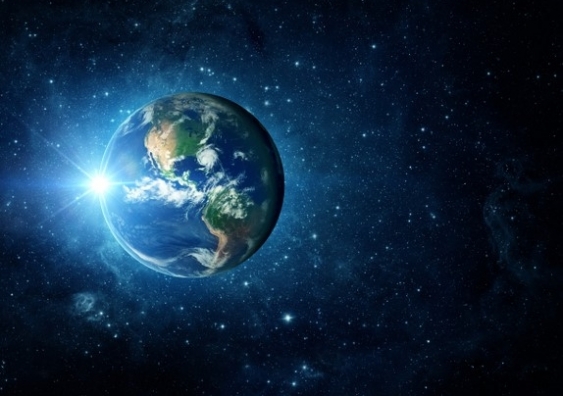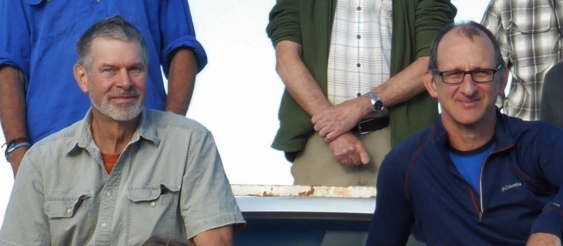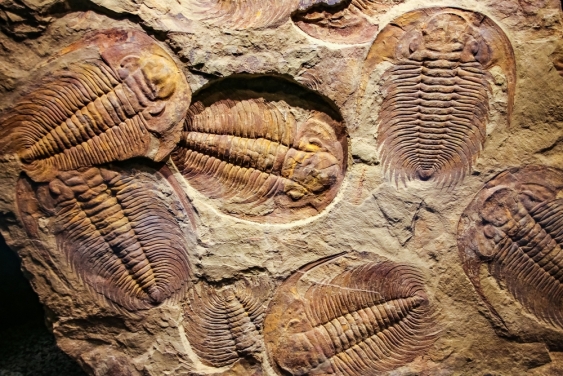The story of Earth and the question no scientist ever asked
The planet's evolutionÌęand âmicrobial poopâ were just some of the wide ranging topics US mineralogist Dr Robert Hazen covered at the UNSW Centre for Ideas eventÌęlast night.
The planet's evolutionÌęand âmicrobial poopâ were just some of the wide ranging topics US mineralogist Dr Robert Hazen covered at the UNSW Centre for Ideas eventÌęlast night.

Diane Nazaroff
0424479199
diane.nazaroff@unsw.edu.au
When acclaimed US mineralogist Robert Hazen was a young boy, he always collected and organised things like stamps or coins. But then he started collecting fossils and minerals, and he realised they told a story.
âThat rock came from some place, it was born at some point, it evolved in certain ways ⊠I became fascinated with those stories,â the Senior Staff Scientist at Carnegie Institutionâs Geophysical Laboratory,Ìęand the Clarence Robinson Professor of Earth Sciences atÌęGeorge Mason University, said during a UNSW Sydney Centre for Ideas event last night.
Dr Hazen was interviewed byÌęMartin Van Kranendonk, who is Professor of Geology and Astrobiology at UNSW Sydney, and is the Director of the Australian Centre for Astrobiology.
Prof. Van Kranendonk has also spent a large part of his life mapping rocks: specifically the ancient rocks of , South Africa, and , and has with geoscientists from around the world on his famous âGrand Tourâ fieldtrip across Western Australia, where he first met Robert Hazen in 2014.Ìę
Dr Hazen told Prof. Van Kranendonk how his childhood rock collections sparked his interest for a career in geology and his research journey that led to one of the great stories in earth science, the idea of mineral evolution. The idea was sparked by a question at a 2006 Christmas party.Ìę
âWe think that life arose during this period of early Earth history called the Hadean,â he said.
âAnd many people are postulating that clay minerals played an important role. And (a Professor friend) said âif clay minerals didnât exist in the Hadean, then those hypotheses canât be rightâ.
âI had never heard anyone ask that question ⊠Nobody ever asked âwhat was the first mineral in the cosmos?â.â

Robert Hazen (L) and Martin Van Kranendonk (R). Image: Supplied.
In 2008, he and seven co-authors wrote a journal paper which came up with the idea that the earth has gone through 10 stages of mineral evolution.
âAt each stage, some new process or event or characteristic came into play that change or altered the near surface, diversity and distribution of minerals,â Dr Hazen said.
âThe biggest punchline of that paper was that more than half of all minerals on Earth are a consequence of living systems,â he said.
âLife changes Earthâs environment; every aspect of geology and hydrology and mineralogy is influenced in ways that we really hadnât articulated before.â
Dr Hazen described how the colours of Earth changed from its beginnings four and a half billion years ago, when it was a black planet âcovered in black basalt, this heavy, dense rock with cracks of bright red incandescence as lava poured out of various fissures and volcanoesâ to the land eventually turning green with âthe evolution of green plantsâ.
âThese colour changes are emblematic of how amazing the evolution of our planet has been, how itâs gone through many stages, each one a consequence of what came before, each one leading to what comes next,â he said.
Asked to explain how a carbon bearing rock came to be at the top of Mount Everest, he said continental masses and plates moving over a hundred million years could be responsible.
âWhat youâre seeing is a limestone formed as part of a coral reef, much like the Great Barrier Reef ⊠sometimes when two continental plates collide, they carry with them coastal zones with coral reefs. You start getting mountains forming then crumpling together, they start raising and pushing together.â
Ìę
Ìę
He also discussed one of the worldâs greatest uncertainties: climate change.
âWhat humans are producing now by burning and producing (carbon dioxide) is 10, 20, 50 times more than the most active volcanoes that have been going on,â he said.
âSo we are suddenly tipping this whole process which was gradual, stately, well controlled, and we're skewing it by burning all of this buried carbon that was locked in the rocks, it wasÌęsequestered. It wasn't going anywhere. But when we burn coal, when we burn oil, when we burn natural gas, carbon that has been locked in the subsurface is suddenly brought back and put into the atmosphere very rapidly ⊠The millions of years it took to make the coal thatâs buried underground isÌę being reversed in a matter of decades.â
Dr Hazen was Executive Director of the Deep Carbon Observatory, a project set up to understand the chemical and biological roles of carbon in Earth, from 2009 to 2019. Ìę
"The Deep Carbon Observatory was really a large scientific program that was designed to understand the hidden 90% of carbon in earth," he said.
âMany people for understandable reasons have studied carbon in the oceans, carbon in the atmosphere, carbon in the shallow crust where we mined it for coal and natural gas.
âBut there is a hidden carbon cycle that goes much deeper ⊠carbon that may be present in the core of Earth, carbon that may be present in various sorts of minerals very far down in what's called the lower mantle. And we had no idea. There was almost no one who had been studying this because it wasn't the main topic.â

Dr Robert Hazen in the Pilbara. Image: Martin Van Kranendonk.
The project was important to gauge how humans were impacting Earth.
âYou really have to know for sure how much carbon is coming out of volcanoes, how much carbon is being sequestered by weathering on Earth's surface, how much carbon is going down in subduction zones, is the amount of carbon going down equal to the amount of carbon coming out, it could be more could be less, we didn't know,â he said.
The baseline, he said, was that humans âare just completely overwhelming every other aspect of the carbon cycle, that what we're doing in the last century and a half, is just unprecedented in earth history ⊠this is just scientific evidence that there is something fundamentally different about what we're doing.â
Prof. Van Kranendonk asked him about the mineral Hazenite, named after Dr Hazen and only found in Mono Lake, California.
âItâs a hyper saline lake, itâs got a very high concentration of phosphorous and some other elements, so high in fact that when microbes live in this lake they canât survive unless they adjust their internal chemistry,â Dr Hazen said.
âOne of the ways they do that is they excrete crystals, a crystal of an alkaline phosphate which is Hazenite. So Hazenite is essentially microbial poop.â
Dr Hazen said he could have been a professional trumpet player.
âWhat I realised very quickly was ⊠you can be a very good musician on the side while doing science. But you canât be a very good scientist on the side while doing music.â
He describedÌęsome of his great science teachers, and also lamented the decline of studentsâ interest in science in high school.
Some science teachers donât appreciate that the career is about asking questions, âitâs not about memorising answersâ, he said.
âYou need to have mentors âŠÌęwho take students in hand and say âyouâve got great questions, letâs see if we can figure out an answerâ.
âThe most exciting thing in science is âIâve got a questionâ ⊠if you can come up with a question that no one has ever thought to ask before, you will be a great scientist.â

500 million year old trilobites in a stone. Image: Shutterstock.
Dr Hazen has continued collecting, amassing over 2000 trilobites, or fossil arthropods (marine animals).
The collection of almost 1000 different species from six continents has been donated to the Smithsonian Museum of Natural History.
He said one of his lifeâs favourite moments was watching a young boy stare in awe at his collection in the museum.
âThat was me when I was a seven or eight year old, going to the museum, looking at the specimens,â he said. Ìę
âWhat better way to pass it forward than to give something that might inspire another young person to become a scientist.â